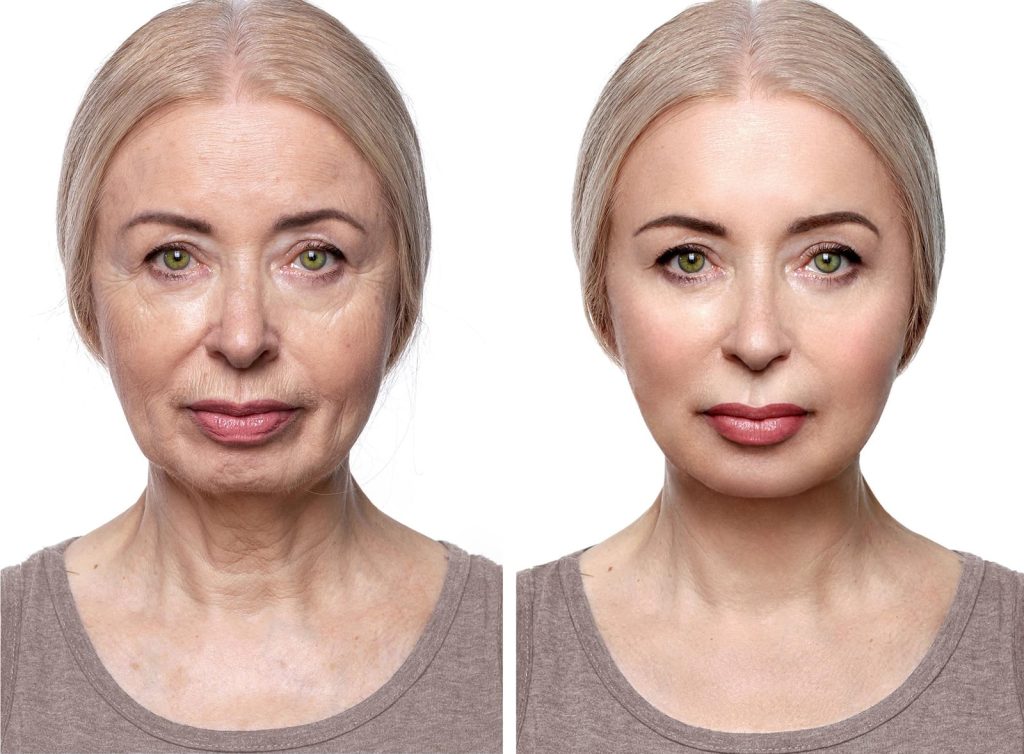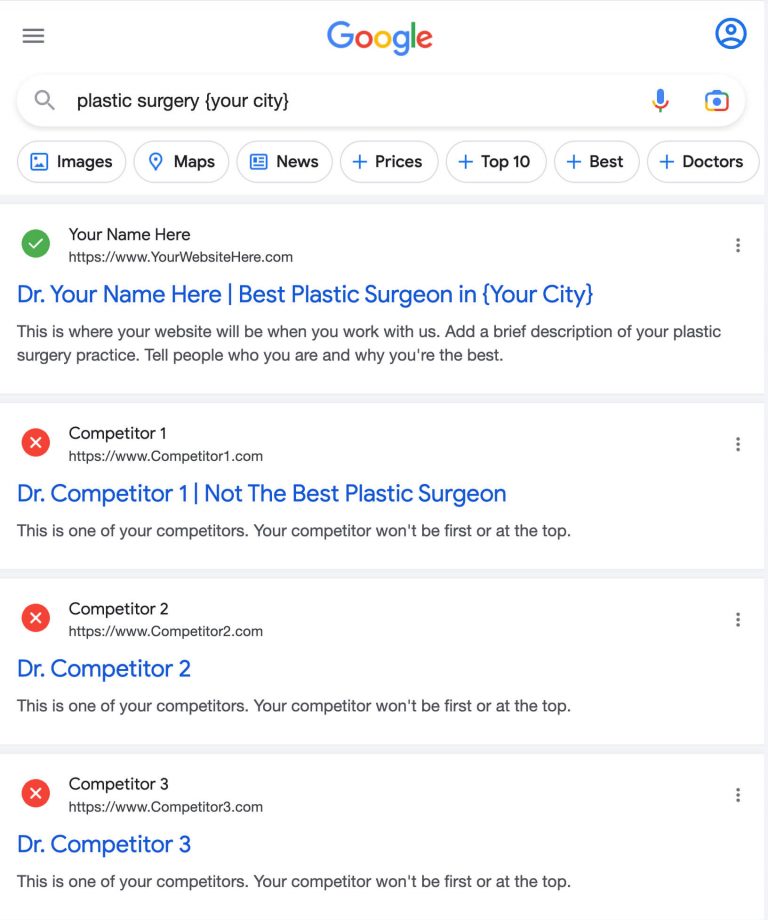Plastic Surgery SEO Guide
The Complete Guide on SEO for Plastic Surgeons
Are you prepared to improve your online presence and attract more qualified leads as a plastic surgeon? Look no further than this Plastic Surgery SEO guide.
This guide is not about what is SEO but rather how to implement it.
We will guide you through the essential strategies and techniques to ensure your website rises to the top of search results when potential patients seek plastic surgery information.
Discover how to conduct keyword research, optimize your website content, and leverage on-page and off-page optimization methods. Learn the art of creating valuable content that establishes you as an authority in your field.
Find out the secrets of a well-optimized website, the key elements of plastic surgery website SEO, and the benefits of content creation and optimization.
Get ready to enhance your online presence and revenue with this comprehensive guide.
Conduct keyword research for targeted SEO

To conduct keyword research for targeted SEO, start by identifying relevant terms that potential patients may use to search for plastic surgery services. This step is crucial in optimizing your website and improving its visibility in search engine results. By using the right keywords, such as “plastic surgeon in [city]”, “breast augmentation surgeon in [city]”, and “cosmetic surgeon”, you can attract more qualified leads and increase your online presence.
Begin by brainstorming keyword ideas that are specific to your plastic surgery practice. Think about the procedures you offer, such as breast augmentation, rhinoplasty, or facelifts, and consider what potential patients might search for when looking for these services. Understanding user intent is also important. Put yourself in the shoes of a potential patient and think about what information they’d be seeking.
Next, research related search terms and utilize keyword research tools to gather data on search volume and competition. This will help you refine your keyword list and select the most effective keywords for your SEO strategy. It’s important to have a mix of head terms, such as “plastic surgery”, and long-tail keywords, such as “best plastic surgeon in [city]”. Checking competitor rankings for keywords can also give you insights into what’s working in your industry.
Here are some tools to help you with keyword research:
We help plastic surgeons rank at the top of search engines and get more patients with data-driven SEO techniques and strategies. Let us help you get more patients and generate more revenue.
Contact UsResearch your competitors in your city

Start by researching your competitors in your city to gain valuable insights and stay ahead in the competitive plastic surgery market. Understanding what other plastic surgery practices in your area are doing can provide you with information about their SEO strategies, website optimization, and the services they offer. By analyzing your competitors, you can identify areas where you can improve and differentiate yourself to attract more leads and potential patients.
To begin your competitor research, start by identifying the plastic surgery clinics in your city that are your direct competitors. Look for practices that offer similar services and target the same audience as your practice. Once you have a list of competitors, visit their websites and analyze their SEO efforts. Pay attention to the keywords they’re targeting, the content they’ve created, and the overall structure and design of their websites.
Take note of any unique features or services that your competitors offer, as this information can help you identify gaps in your own offerings. For example, if a competitor has a strong emphasis on a particular procedure or specializes in a certain area of plastic surgery, you may want to consider incorporating similar services into your practice to attract more patients.
Additionally, look at the backlinks that your competitors have. Backlinks from reputable websites can improve your website’s authority and search engine rankings. By identifying the websites that are linking to your competitors, you can reach out to them and potentially secure backlinks for your own website.
Create high-quality content about plastic surgery that patients want to read

To establish yourself as an expert in plastic surgery, it’s essential to create high-quality content that patients find valuable.
By understanding the needs and concerns of your target audience, you can tailor your content to provide informative answers and address their questions.
This approach won’t only attract qualified leads but also build trust and credibility, leading to increased website traffic and higher conversion rates.
Position yourself as the expert
By creating informative and valuable content about plastic surgery that patients want to read, you can establish yourself as an expert in the field. This is an essential strategy to incorporate in your plastic surgery SEO campaigns and overall marketing efforts.
To effectively position yourself as an expert, consider the following:
- Conduct thorough research on plastic surgery topics to ensure the content you create is accurate and up-to-date.
- Use engaging and informative language that resonates with your target audience.
- Address common questions and concerns that patients may have about plastic surgery procedures.
- Provide valuable insights and tips that showcase your expertise and build trust with your audience.
Create plastic surgery SEO content with the right intent
With the aim of providing valuable information to patients, create high-quality content about plastic surgery that resonates with their needs and interests. This is an important aspect of plastic surgery SEO and content marketing.
By incorporating relevant keywords and addressing common questions and concerns, you can optimize your website for search engines and attract more potential patients.
Focus on delivering informative articles that educate readers about different surgical procedures, recovery processes, and potential outcomes. Offer insights into the latest advancements in plastic surgery and share success stories from satisfied patients.
Develop before and after transformations for visual impact

Create a comprehensive collection of before and after photos to enhance the visual impact of your plastic surgery website. Before and after galleries are an effective tool for showcasing the transformative results of cosmetic surgery procedures.
Here are some reasons why developing before and after galleries is essential for effective plastic surgery SEO:
- Visual Impact: Before and after photos provide a visually compelling way to demonstrate the skills and expertise of your plastic surgeons. Potential patients are more likely to be convinced by concrete evidence of successful outcomes.
- Engage Potential Patients: Before and after galleries capture the attention of potential patients and keep them interested in your website. By showcasing the dramatic changes that can be achieved through cosmetic surgery, you can inspire trust and confidence in your services.
- SEO Benefits: Including before and after photos on your plastic surgery website can boost your search engine optimization efforts. Optimizing image alt tags with relevant keywords and providing detailed captions can help improve your website’s visibility in search results.
- Showcasing Expertise: Before and after galleries allow you to highlight the range of procedures you offer and the expertise of your plastic surgeons. By showcasing a diverse selection of successful outcomes, you can demonstrate your ability to deliver exceptional results.
Incorporating before and after galleries into your plastic surgery website is a powerful way to visually communicate the transformative effects of cosmetic surgery. By optimizing these galleries for search engines and showcasing a wide range of successful outcomes, you can attract more potential patients and establish your practice as a trusted provider of plastic surgery services.
Showcase patient testimonials and photos from your plastic surgery practice for credibility

To establish credibility for your plastic surgery practice, showcase patient testimonials and photos.
Sharing testimonials and photos from your satisfied patients on your plastic surgery website is an effective way to build trust and credibility with potential clients. When prospective patients see real-life examples of successful outcomes and read positive experiences from others, they’re more likely to feel confident in choosing your practice for their cosmetic surgery needs.
By featuring patient testimonials, you’re providing social proof, demonstrating that your plastic surgery practice has a track record of delivering excellent results and satisfied clients. Testimonials should highlight the positive experiences and outcomes that patients have had with your practice. They can touch on various aspects, such as the professionalism of your plastic surgeons, the quality of care provided, and the overall satisfaction with the results.
In addition to testimonials, showcasing before and after photos of your patients can further enhance your credibility. These visual representations of your work allow potential clients to see the transformations that can be achieved through your expertise. Make sure to obtain consent from patients before using their photos and ensure that you adhere to patient confidentiality and privacy regulations.
When creating a section for testimonials and photos on your plastic surgery website, organize them in a user-friendly and visually appealing format. Consider including captions or brief descriptions to provide context for the photos. This will help potential clients easily navigate and understand the information presented.
Incorporate video content with plastic surgeons and patients for engagement

Include videos featuring plastic surgeons and patients to enhance engagement on your plastic surgery website. Video content is a powerful tool for connecting with your audience and providing them with valuable information. Here are some reasons why you should incorporate video content into your plastic surgery SEO strategy:
- Increase engagement: Videos capture attention and keep visitors on your website longer. By showcasing plastic surgeons and patients in videos, you can create a personal connection and build trust with your audience. Engaging videos can lead to higher conversion rates and more qualified leads.
- Educate and inform: Video content allows you to explain complex procedures, share testimonials, and showcase before and after results. By providing contextually relevant information in an easily digestible format, you can educate potential patients and address their concerns. This helps build credibility and positions you as an expert in the field.
- Enhance user experience: Incorporating videos into your website improves the overall user experience. It provides a dynamic and interactive element that can make your site more enjoyable to navigate. Videos can also be used to guide visitors through different sections of your website or explain the benefits of specific procedures.
- Boost search engine rankings: Search engines like Google prioritize websites with diverse and engaging content. By incorporating video content, you can improve your website’s visibility and rankings. Be sure to optimize your videos with relevant keywords, tags, and descriptions to increase their chances of appearing in search results.
Incorporating video content featuring plastic surgeons and patients into your plastic surgery website is a powerful way to enhance engagement, educate your audience, improve user experience, and boost your search engine rankings. By providing valuable and contextually relevant video content, you can establish credibility, build trust, and attract more qualified leads to your practice.
We help plastic surgeons get more patients with data-driven SEO techniques and strategies. Let us help you get more patients and generate more revenue.
Contact UsImprove your plastic surgery website speed for better performance

The speed of your website plays a crucial role in its overall performance and user experience. A slow-loading website can lead to high bounce rates, lower conversion rates, and frustrated visitors. Additionally, website speed is an important ranking factor for SEO.
To improve the speed of your plastic surgery website and achieve better performance, there are several key factors to consider.
First, evaluate your hosting service. Choose a reliable hosting provider that can handle the traffic and demands of your website. Additionally, optimize your website theme and remove any unnecessary elements that may slow down loading times.
Large file sizes and poorly written code can also affect your website’s speed. Compress images and videos to reduce their file sizes and ensure that your code is clean and efficient.
Furthermore, limit the use of plugins and widgets on your website as they can increase loading times. Utilizing a content delivery network (CDN) can also help distribute your website’s content and improve loading speeds.
Redirects can also impact your website’s speed. Minimize the number of redirects and ensure they’re properly configured to avoid unnecessary delays.
To check if your page loads slowly, use online tools or Google’s PageSpeed Insights. These tools will provide insights and recommendations for optimizing your website’s speed.
Optimizing the speed of your plastic surgery website is crucial for better performance and improved SEO rankings. By implementing these strategies and continuously monitoring your website’s loading times, you can provide a seamless user experience and attract more visitors to your site.
Secure your website (HTTPS) for safety

Now let’s explore securing your plastic surgery website for safety. It’s crucial to prioritize the safety of your website to protect both your practice and your patients. Here are the key steps to secure your website and ensure a safe online environment:
Implement HTTPS: HTTPS, or Hypertext Transfer Protocol Secure, is a secure version of HTTP that encrypts the data exchanged between a user’s browser and your website. It’s essential for protecting sensitive information such as patient data or online transactions. By obtaining an SSL certificate and enabling HTTPS, you provide a secure browsing experience and build trust with your visitors.
You should also regularly update and patch your website. Keeping your website’s software, plugins, and themes up to date is vital for maintaining security. Updates often include security patches that fix vulnerabilities and protect against potential threats. Neglecting updates can leave your website exposed to hackers and malware.
Another way to keep your website secure is to use strong and unique passwords. Weak passwords are a common entry point for hackers. Ensure that all user accounts on your website, including yours and your staff’s, have strong and unique passwords. Use a combination of uppercase and lowercase letters, numbers, and special characters. Consider implementing two-factor authentication for an extra layer of security.
Regularly backup your website. Regularly backing up your website is crucial in case of any unexpected incidents or data loss. Choose a reliable backup solution and schedule regular backups to ensure that you can quickly restore your website to its previous state if necessary.
Enhance user experience (UX) for visitor retention

To improve user experience (UX) and increase visitor retention, focus on creating a seamless and engaging website interface. A well-designed and user-friendly website is crucial for attracting and retaining visitors to your plastic surgery website. By optimizing your website design and implementing user-friendly features, you can enhance user engagement and boost website traffic.
Website optimization plays a vital role in improving user experience. Start by ensuring that your website loads quickly and is mobile-friendly. Slow-loading websites can frustrate visitors and lead to high bounce rates. Additionally, ensure that your website has a clean and intuitive navigation menu, making it easy for visitors to find the information they need.
Engaging content is another essential factor in enhancing user experience. Regularly update your website with valuable and informative content, such as blog posts and articles. Optimize your content with relevant keywords to improve search engine visibility and attract organic traffic. Consider incorporating before and after photos, testimonials, and reviews to showcase your expertise and build trust with potential patients.
To further enhance user experience, encourage user engagement on your website. Incorporate interactive features such as live chat or contact forms to make it easy for visitors to reach out and ask questions. Respond promptly and provide helpful information to ensure a positive user experience.
Build backlinks for increased authority

To further establish your authority in the field of plastic surgery, it’s important to actively build backlinks from reputable websites. Backlinks are like endorsements or recommendations from other websites, and they play a crucial role in improving your website’s ranking on search engines.
Here are some effective strategies to help you build effective backlinks and increase your authority in plastic surgery SEO:
- Identify relevant websites and pages for backlink opportunities: Look for websites and pages that are related to plastic surgery or medical topics. These websites are more likely to provide valuable backlinks that can enhance your website’s authority.
- Reach out to website owners or content creators for collaboration: Establish relationships with influential website owners or content creators in the plastic surgery industry. Collaborate on guest blog posts, interviews, or other content opportunities that can earn you backlinks and increase your visibility.
- Create high-quality content that others would want to link to: Develop informative and engaging content that showcases your expertise in plastic surgery. When you provide valuable information, other websites are more likely to link back to your content, thereby increasing your authority.
- Utilize social media and online communities to promote your content: Share your content on social media platforms and engage with relevant communities online. By promoting your content, you can attract more attention and encourage others to link back to your website, further boosting your authority.
Building backlinks from reputable websites is a crucial part of your plastic surgery SEO strategy. It not only helps increase your website’s ranking on search engines but also enhances your authority in the field. By actively pursuing backlink opportunities and creating high-quality content, you can establish yourself as a trusted source in the plastic surgery industry.
Use social media as a plastic surgeon to share your content

You should regularly use social media as a plastic surgeon to share your content with potential patients. Social media platforms provide an excellent opportunity for you to reach a wider audience and promote your expertise in the field of cosmetic surgery. By leveraging social media, you can effectively incorporate online marketing and digital strategies into your overall marketing plan.
Social media marketing allows you to share valuable content related to plastic surgery, such as informative articles, before and after photos, videos, and patient testimonials. By sharing this content, you can educate and engage with your audience while establishing yourself as a trusted plastic surgeon.
To effectively promote your content on social media, you can utilize various strategies. First, identify the social media platforms that your target audience is most active on, such as Facebook, Instagram, or YouTube. Then, create engaging posts that incorporate relevant keywords and hashtags related to plastic surgery. This will help increase the visibility of your content and attract potential patients who are searching for information in your field.
Additionally, consider using social media advertising to further promote your content. Platforms like Facebook and Instagram offer targeted advertising options that allow you to reach specific demographics and geographic locations, ensuring that your content is seen by the right audience.
Remember to consistently monitor and engage with your social media audience by responding to comments, answering questions, and sharing valuable insights. This will help you build a strong online presence and foster trust with potential patients.
Use schema markup and structured data for better content understanding

Implementing schema markup and structured data improves content understanding and enhances search engine visibility. By using schema markup and structured data on your plastic surgery website, you can provide search engines with additional information about your content, making it easier for them to understand and index your website accurately.
Here are several benefits of using schema markup and structured data:
- Increased relevance: Schema markup allows you to provide specific information about your content, such as the type of procedure or treatment being discussed. This helps search engines understand the relevance of your content to specific keywords and improves the chances of your website appearing in relevant search results.
- Enhanced search engine rankings: When search engines have a better understanding of your content, they can rank it higher in search results. Schema markup and structured data provide additional context to search engines, increasing the chances of your website appearing on the first page of search results.
- Rich snippets: Schema markup can enable the display of rich snippets in search engine results. Rich snippets provide additional information, such as star ratings, reviews, and other details, directly in the search results, making your website stand out and increasing the likelihood of attracting clicks from users.
- Improved user experience: By implementing schema markup and structured data, you can enhance the user experience on your website. Clear and structured information helps users find the information they need more easily, improving their overall experience and increasing the likelihood of them staying on your website longer.
Update content regularly for relevance

Regularly updating your content is crucial for maintaining relevance and staying ahead of the competition in plastic surgery SEO. In the ever-evolving world of search engine optimization, it’s important to keep your content fresh and up to date. By regularly updating your content, you can ensure that it remains relevant to your target audience and continues to provide value.
Updating your content on a regular basis not only helps you stay ahead of the competition but also improves the quality of your content. Outdated information can make your content less authoritative and relevant, which can negatively impact your search engine rankings. By updating your content, you can ensure that it remains accurate, informative, and valuable to your readers.
To update your content regularly for relevance, start by identifying the pages that need revision. Look for pages that used to rank well but have fallen off, as well as pages that never performed well despite a solid strategy. Prioritize pages that can attract high traffic or contribute to your website goals. Also, look for outdated pages or those that no longer align with your current brand messaging or target audience.
When updating your old content, there are a few key considerations to keep in mind. Verify and update facts and figures for accuracy and relevance. Evaluate the function of the content and make improvements to match searcher intent. Conduct keyword research and optimize the title, title tag, and subheadings for searcher language. Enhance the user experience by adding interactive elements for more value. Review and improve the content structure, readability, and organization for better user engagement.
Manage your online reputation across all platforms

How can you effectively manage your online reputation across all platforms?
Online reputation management is crucial for plastic surgery practices to establish trust and credibility with potential patients. Here are unique strategies to help you manage your online reputation:
- Monitor your online presence:
Regularly monitor your online presence across all platforms, including social media, review sites, and search engine results. Set up alerts to be notified of any mentions of your practice. This allows you to stay informed and respond promptly to any feedback or reviews. - Respond to reviews and feedback:
Address both positive and negative reviews in a timely and professional manner. Thank patients for their positive feedback and address any concerns raised in negative reviews. Show that you value patient feedback and are committed to providing excellent care. - Engage with patients on social media:
Actively engage with patients on social media platforms by responding to comments and messages. Share informative and engaging content that showcases your expertise and highlights patient success stories. Building a positive online community can help strengthen your reputation. - Optimize your Google Business Profile:
Your Google Business Profile is often the first impression potential patients have of your practice. Optimize it by adding accurate and up-to-date information, high-quality photos, and positive reviews. Regularly check and respond to patient reviews on your profile to demonstrate your commitment to patient satisfaction.
We help plastic surgeons get more patients with data-driven SEO techniques and strategies. Let us help you get more patients and generate more revenue.
Contact UsList in online directories and citations for cosmetic surgeons for increased visibility

To improve the SEO of your plastic surgery website and enhance the visibility of your cosmetic surgery practice, it’s crucial to list your business in online directories and citations.
Online directories serve as platforms where businesses can be listed and categorized to facilitate potential patients in finding you. Citations, on the other hand, act as online references to your business that typically include your business name, address, and phone number (NAP).
Listing your cosmetic surgery practice in online directories and citations can significantly boost your visibility in search engine results. When individuals search for cosmetic surgeons in their vicinity, having your practice listed in relevant directories increases the likelihood of your business being discovered. Moreover, it enhances the credibility and authenticity of your practice, as being listed in reputable directories contributes to your online presence.
Several popular online directories exist where you can list your cosmetic surgery practice, such as Google My Business, Bing Maps, Facebook, and Yelp. These directories are widely utilized by potential patients when searching for businesses like yours. By listing your practice in these directories, you can take advantage of their high rankings in local searches, thereby increasing your visibility on the first page of search results.
In addition to improving visibility, listing your cosmetic surgery practice in online directories and citations can also drive referral traffic to your website. People often rely on specific directories, like Yelp for reviews or YellowPages for contact information when searching for businesses. Being listed in multiple directories heightens the chances of being found and generates valuable referral traffic to your website.
To select the appropriate citations for your cosmetic surgery practice, begin with industry-specific online directories that are relevant to your business. Moz and WhiteSpark provide lists of top industry citations by category, while BrightLocal offers popular general directories. It’s essential to prioritize directories that potential customers actually use to ensure maximum visibility.
Consider utilizing citation management tools to streamline the process of listing your business in online directories. These tools can assist in setting up and managing citations, suppressing duplicates, and tracking the accuracy of your listings. Evaluate the features and pricing of different tools to find the best fit for your needs.
Set the correct meta tags with important information about your page

To ensure optimal visibility and improve your plastic surgery SEO, it’s crucial that you set the correct meta tags with important information about your page. Meta tags provide valuable information to search engines and users, helping them understand the content and relevance of your page.
Here are the key elements to consider when setting meta tags for your plastic surgery website:
- Meta Title: The meta title is the page title displayed in search results. It should be unique, descriptive, and attention-grabbing, accurately representing the content of your page. Keep the title under 60 characters to ensure it’s fully displayed in search results.
- Meta Description: The meta description summarizes the page’s content and is often used in search result snippets. It influences users’ decision to click on your page, so make it unique, accurate, and attention-grabbing. Keep the description under 160 characters.
- Meta Robots: The meta robots tag controls how search engines crawl and index your webpages. It includes values like index, noindex, follow, and nofollow. Customize the tag to provide specific instructions for search engine bots.
- Meta Charset: The meta charset tag defines the character encoding for your webpage, ensuring that the content is displayed correctly. Use the recommended UTF-8 character encoding for modern webpages.
Utilize tracking and analytics for insights
To gain valuable insights into the performance of your plastic surgery SEO efforts, make use of tracking and analytics tools. Tracking and analyzing data is essential for understanding how your website is performing in search engine rankings and identifying areas for improvement. By utilizing tracking and analytics tools, you can monitor important metrics such as keyword rankings, organic traffic, user engagement, and conversion rates.
Tracking tools, such as Google Analytics, provide detailed information about the behavior of visitors on your website. You can track the number of visitors, the pages they visit, how long they stay on each page, and the actions they take. This data can help you understand which pages are performing well and which ones may need optimization.
Analytics tools, on the other hand, allow you to analyze the data collected from tracking tools. You can uncover valuable insights about your audience, such as their demographics, interests, and behavior patterns. This information can help you tailor your content and marketing strategies to better engage with your target audience.
By utilizing tracking and analytics tools, you can also identify the keywords that are driving the most traffic to your website. This information can guide your SEO efforts by allowing you to optimize your content and target relevant keywords.
How to Improve Local SEO For Plastic Surgeons

Ways to Optimize your Google My Business (Google Business Profile)
Improve your local SEO as a plastic surgeon by optimizing your Google Business Profile (used to be called Google My Business). This is an essential step in your plastic surgery SEO campaign to increase visibility and attract more traffic to your website.
Here are four important tips to optimize your Google Business Profile:
- Provide accurate and detailed information: Optimize your profile by ensuring that your business name, address, phone number, and website are accurate and up-to-date. This will help potential patients find your practice easily.
- Add high-quality photos: Showcase your expertise by adding high-quality photos of your clinic, staff, and before and after pictures. Visual content can attract and engage potential patients.
- Encourage and respond to reviews: Positive reviews on your profile can establish your brand authority and increase the likelihood of patients choosing your practice. Encourage patients to leave reviews and respond to them promptly to build trust.
- Select relevant categories and attributes: Choose relevant categories and attributes for your business to improve visibility in local search results. This will help Google understand the nature of your practice and connect you with the right audience.
What is Plastic Surgery SEO
How to Get Your On-Page SEO Right
- Choose relevant keywords: Conduct keyword research to identify the most relevant and high-performing keywords for your plastic surgery services. Incorporate these keywords contextually in your website content, including the page titles, headings, and throughout the body of your articles.
- Write informative and engaging content: Create valuable content that addresses the needs and concerns of your target audience. Use research-based keywords in your articles and provide informative answers to common questions related to plastic surgery. Regularly update your content through blogging to show Google that your website is a reliable source of fresh information.
- Optimize your URLs and internal links: Ensure that your URLs are descriptive and include relevant keywords. This helps search engines understand the content of your pages. Additionally, use internal links to improve website navigation and help search engines understand the structure of your site.
- Include and optimize images: Images can improve user engagement on your website, but they also need to be optimized for SEO. Use descriptive file names and alt tags that include relevant keywords. This helps search engines understand the content of the images and improves the overall relevance of your pages.
Frequently Asked Questions (FAQ)
How Can I Conduct Keyword Research for Targeted SEO in the Field of Plastic Surgery?
To conduct keyword research for targeted SEO in the field of plastic surgery, begin by brainstorming relevant terms and phrases. Utilize tools such as Google Keyword Planner and SEMrush to analyze search volume and competition. Concentrate on keywords that align with your practice and attract potential patients.
What Are Some Strategies for Researching Competitors in My City in Order to Improve My Plastic Surgery Seo?
To research competitors in your city and improve your plastic surgery SEO, analyze their website content, keywords, backlinks, and online reputation. Use tools like SEMrush and Moz to gain insights and identify areas for improvement.
How Can I Create High-Quality Content About Plastic Surgery That Will Attract and Engage Patients?
To create informative content about plastic surgery that appeals to and engages patients, prioritize addressing their frequently asked questions, offering valuable insights, and incorporating relevant keywords based on research. Utilize blog posts, optimized landing pages, and testimonials strategically to demonstrate your expertise and establish a connection with prospective patients.
What Are the Benefits of Developing Before and After Galleries for Visual Impact on My Plastic Surgery Website?
Developing before and after galleries for your plastic surgery website has several advantages. They provide a strong visual impact, highlight your expertise, establish trust with potential patients, and assist them in envisioning the achievable results.
How Can I Effectively Showcase Patient Testimonials and Photos From My Plastic Surgery Practice to Establish Credibility?
To effectively showcase patient testimonials and photos from your plastic surgery practice and establish credibility, create a dedicated page on your website. Include compelling testimonials, high-quality before and after photos, and patient stories that highlight successful outcomes and positive experiences.
We help plastic surgeons get more patients with data-driven SEO techniques and strategies. Let us help you get more patients and generate more revenue.
Contact Us